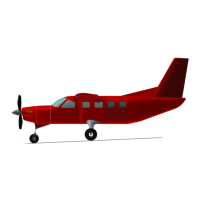OPTIONAL PITCH LATCH PROPELLER
For water operations, it is undesirable to feather the propeller when the
engine is stopped after landing the aircraft. If the engine is subsequently
started with the propeller in the feathered position, residual thrust complicates
docking and handling of the aircraft.
To prevent feathering the propeller (as during normal engine shutdown), the
propeller incorporates spring-energized latch pins, called auto high pitch stop
units. Two units are installed on the propeller cylinder. When the propeller
RPM is approximately 800 or above, centrifugal force disengages the latch
pins from the piston, allowing it to move as needed between the reverse
and feather stops. When the RPM falls below this value, a spring in each
auto high pitch stop unit overcomes the centrifugal force on the latch pin,
causing it to retract into the cylinder and engage the piston, preventing it
from moving in the feather direction. To engage the stop units upon engine
shutdown, the propeller control must be placed into the reverse thrust position
before stopping the engine. Upon stopping, a large spring in the propeller
moves it toward the feathered position, but as the RPM decreases below
approximately 800, the retracted latch pins engage the piston, preventing the
propeller from feathering.
Upon starting the engine, the propeller is already in at pitch. What little
thrust is generated while starting the engine does not present a handling
problem for the aircraft. To disengage the latches before taxi and ight, the
power lever must be placed momentarily in the reverse thrust position while
at low power. This removes the lateral friction force from the latch pins and
prevents them from being damaged by application of power. After adding
sufcient power to advance the RPM above 800, the latch pins move to an
outward position and remain there, allowing full control of the propeller.
OVERSPEED GOVERNOR TEST SWITCH
An overspeed governor test switch is installed on the upper left portion of the
instrument panel. The switch is a push-to-test type and is used to test the
overspeed governor during engine run-up. When the switch is depressed,
a solenoid is actuated on the propeller overspeed governor, which restricts
propeller RPM when the power lever is advanced. To check for proper
operation of the overspeed governor, during engine run-up, press and hold
the push-to-test switch and advance the power lever until the propeller RPM
stabilizes. The propeller RPM should stabilize at 2070 ± 50 RPM.

